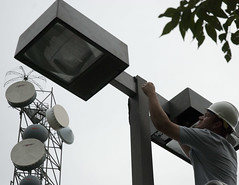 Streetlights can be a surprisingly big drain on a community’s budget, but thanks to new technology, cities & counties can slash their energy bills & carbon footprints. San Diego alone is saving millions:
Streetlights can be a surprisingly big drain on a community’s budget, but thanks to new technology, cities & counties can slash their energy bills & carbon footprints. San Diego alone is saving millions:
The city is replacing its old low-pressure sodium lights – a common streetlight – with induction bulbs that use about 40 percent less energy. 16,500 have already been converted, and officials expect the transition to be finished by next spring. Before the conversion, the city had been paying about $4.7 million a year to light its streets. When all 35,000 lights are replaced, that cost will drop to about $2.8 million a year, according to Tom Blair, deputy environmental services director for the City of San Diego.
And it’s not just energy costs that will go down. The old sodium bulbs typically had to be replaced every 3 or 4 years, while the new induction bulbs can last more than a decade. Blair says a set of induction bulbs were installed in downtown San Diego about 12 years ago and have yet to need replacement. “That’s a significant savings,” Blair says.
“It was kind of a no-brainer,” says Marty Turock, a program manager at CleanTECH San Diego. “Virtually every city, at least within San Diego County, recognized that doing the street lighting retrofits was one of the biggest impacts and one of the biggest payback energy efficiency projects they could take on.”
Another leader – Ann Arbor, MI, projected to save $100,000 a year by installing new LED streetlights with motion detectors (unlike older streetlight bulbs that need a few minutes to power up to full intensity, LEDs can fire up instantly).



 Sign up for the Blue Virginia weekly newsletter
Sign up for the Blue Virginia weekly newsletter![Monday News: “Trump Tells Americans What Putin Wants Them to Hear”; “Clown-Show Fascism”; “Is the US Becoming an Autocracy?” “Trump took the US economy to the brink of a crisis in just 100 days”; “The weekend that sent the [VA GOP] into a tailspin”](https://bluevirginia.us/wp-content/uploads/2025/04/montage0428-238x178.jpg)






![Video: Trump’s Former VA Campaign Chair Says “Youngkin is going to ostracize [Reid] from the ticket, which means that Reid is going to get blown out and can’t raise money.”](https://bluevirginia.us/wp-content/uploads/2025/04/fredericks0428-100x75.jpg)
